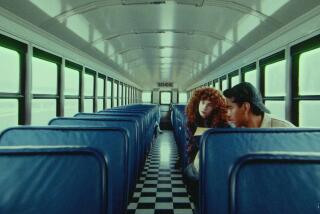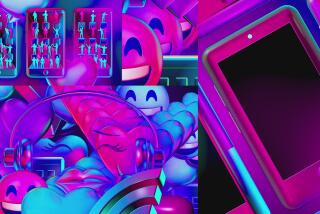Inside the race for the perfect quarantine music video
- Share via
Cages don’t come more gilded than Drake’s in the music video for his song “Toosie Slide.”
Released in early April, a couple of weeks after fears of the coronavirus triggered shelter-in-place orders around much of the world, the clip with more than 85 million views on YouTube follows the superstar Canadian rapper as he roams his colossal Toronto home wearing gloves, a face mask — and, one presumes, the unworried expression of a man who expects to ride out quarantine in splendor.
Here he is fondling an MTV Video Music Award in a trophy room that resembles a jewelry store; there he is pausing to take a seat on a marble-topped kitchen island bigger than some studio apartments.

The opulent display — “overwhelming high luxury” is how Drake described the place to Architectural Digest — makes for a marked contrast with another video shot in confinement: “Weird!” by Yungblud, in which the up-and-coming English pop-punk artist is seen bouncing off the walls of the cramped rental he shares with his band near Venice Beach.
Instead of gliding Steadicam-style photography, it offers grainy footage apparently captured using Apple’s Photo Booth app; instead of sofas draped with expensive-looking throws, an unmade bunk bed straight out of an Ikea catalog.
“‘I’m a celebrity trapped in my mansion’ — that’s exactly what we’re not doing,” Yungblud said in an interview, adding that he’d been inspired in part by his disgust at clips like “Toosie Slide” and a widely pilloried Instagram video showing Gal Gadot and other famous folks warbling John Lennon’s “Imagine” amid similarly plush surroundings.
California is slowly reopening, providing hope that you might soon see your favorite artist in concert. But from an arena stage? A computer screen? A drive-in?
“I wanted to do a video my fans could have done themselves in their bedroom,” he continued, proudly estimating the video’s budget at $100. “It needed to be relatable because it’s not about being above everyone right now. And I’m not some wanker that can afford a five-grand camera.”
For all their differences in approach, “Toosie Slide” and “Weird!” are both solutions to the same problem: How do musicians present themselves — and maintain connections to their audiences — amid a once-in-a-century crisis defined by isolation? Concerts have been called off indefinitely, which has led some acts to delay albums widely regarded these days as drivers of ticket sales.

In response, many have sought communion on social media with unvarnished performances streamed live from bedrooms and garages and studios. But the carefully edited music video has also become a go-to medium for expression — a space to renegotiate (or, as with Drake, to reaffirm) the social contract of pop stardom in the age of social distancing.
The upper end of YouTube’s most-watched chart is peppered with videos that have an identifiable coronavirus theme of some kind, be it the kingly seclusion of “Toosie Slide” — the “Citizen Kane” of quarantine videos — or the cleaning crew in biohazard suits wiping down a kitchen in “Jump” by DaBaby featuring YoungBoy Never Broke Again.
Further down the list, there are Rod Wave’s “The Last Sad Song,” in which the singer and rapper from Florida mills around outside his home wearing a surgical mask, and “Times Like These,” a cover of the Foo Fighters tune by a virtual supergroup that includes Dave Grohl, Dua Lipa and Ellie Goulding, each remote collaborator in his or her own little square of the screen.

That shared-screen look — a knowing link to the Zoom conferences in which many work-at-home types are spending their hours — crops up in plenty of other recent videos. In Weezer’s “Hero,” frontman Rivers Cuomo writes a letter of thanks to essential workers and first responders, then “passes” it to someone in another frame, who passes it to someone else, and so on; OneRepublic’s “Better Days” takes a similar tack, stringing together clips submitted by quarantined fans in an effort to “show everyone’s resilience in the middle of this global pandemic,” as a title card puts it.
In these videos we see stars assuming a familiar pose as providers of inspiration — members, essentially, of the “We Are the World” choir, only separated to meet the demands of this emergency.
Yet other videos emphasize the loneliness the pandemic has bred among even those we turn to for reassurance. “Wasted on You,” the lead single from Evanescence’s first album in nearly a decade, is full of haunting close-ups of singer Amy Lee, who looks crushed by the thought of one more day by herself; in “I Know Alone” the sisters of Haim move through choreography that suggests a listless scroll through Instagram. Then there’s Kehlani’s “Toxic,” in which the R&B singer — having had some wine and locked herself in her room, as she wrote on Twitter — performs what might be history’s moodiest striptease.
The limitations of quarantine have pushed certain artists to new levels of creative ingenuity. Soccer Mommy, the smart indie-rock act led by 22-year-old Sophie Allison, just released a series of animated clips designed in the 8-bit style of old-school Nintendo games; each one takes place in a city Allison was scheduled to play before her tour was postponed.

And in his “Bali” video, the L.A. rapper Rich Brian uses a drone equipped with a camera to collect images of an eerily deserted cityscape as the drone delivers gifts to pals such as Cuco and Thundercat. The elaborate concept calls to mind the storytelling ambition of peak-era MTV even as the parade of alt-culture figures reminds you that we’ve yet to see lockdown efforts from that era’s true A-list inheritors: your Taylor Swifts and Beyoncés and Katy Perrys. Lady Gaga’s “Stupid Love,” which came out in late February and finds the singer cavorting with dozens of dancers in an alien landscape, plays now like the last gasp of the Before Times.
Not everyone who’s made a quarantine video set out intending to. Back in March, Jack Gilinsky — known to Vine users as half of the internet-famous pop-rap duo Jack & Jack — was preparing to shoot a glossy, high-budget clip for his solo single “My Love” in L.A. with Diane Martel, the veteran music-video auteur behind such classics of the form as Robin Thicke’s “Blurred Lines” and “We Can’t Stop” by Miley Cyrus.
But after Gilinsky flew home to his native Omaha to hunker down with his family, Martel reconceived “My Love” as an intimate performance piece, directing the singer over FaceTime as he writhed shirtless in his childhood bedroom.
“A few times my mom walked in on me under the sheets — like, ‘Uh, Jack, what are you doing?’” Gilinsky recalled. “I was like, ‘Don’t worry about it, Mom.’”

“Wildflower,” by the Australian group 5 Seconds of Summer, similarly downsized from a planned soundstage shoot to each member performing on his own in front of a dinky green screen. Yet the colorful, lightly psychedelic result has a soothing quality that guitarist Michael Clifford said he ended up preferring to what they’d originally envisioned.
With its many tight shots of the guys’ stubbly faces, “Wildflower” also uses the tools at hand to give the band’s young audience what it wants: a virtual — and highly meme-able — encounter with four heartthrobs at a moment when pop can serve as a much-needed balm.
Indeed, creating a video has provided a welcome distraction for some artists, just as it has for the millions of TikTok users whose do-it-yourself inventions are starting to shape the look and feel of professional productions. “We were craving a homework assignment,” said Haim’s Alana Haim of learning the dances in “I Know Alone,” which resembles any number of viral TikTok clips. “It took us out of our rut and gave us a sense of energy and brightness.”
Said Yungblud: “I’m riddled with ADHD, so I was buzzing to run around my living room.”

Even so, one of the most striking videos to emerge from quarantine is less an off-ramp from boredom and fear than a tunnel deep into the strange mental state that can develop after nearly two months of sheltering at home.
Posted last week on YouTube, “Yoga” follows the squeaky-voiced New York rapper 645AR as he’s lured by a tiny animated creature from his apartment to an empty Times Square, where a different cartoon character shoots lasers from its oversized eyes; the whole thing has a fractured digital feel, as though your brain has begun to splinter from too much screen time.
“Yoga” ends (though not before an appearance by a female octopus in a gas mask) with 645AR turning toward the viewer and re-creating a scene in “Men in Black” where Will Smith’s character uses his pen-shaped device to wipe ghastly memories from people’s minds.
How’s that for an overwhelming luxury?
More to Read
The biggest entertainment stories
Get our big stories about Hollywood, film, television, music, arts, culture and more right in your inbox as soon as they publish.
You may occasionally receive promotional content from the Los Angeles Times.











